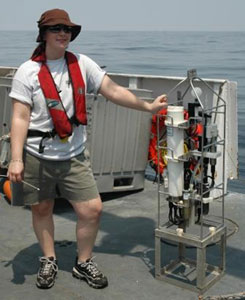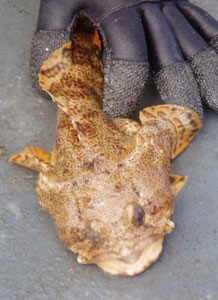| Monday,
May 16, 2005
Today’s
survey plan is similar to the others…more traps,
dives, and CTD’s (picture below).
There is one  difference,
however. Kate will collect acoustic profiles of the sanctuary.
These data are collected with a transducer while motoring
along a series of transects through the sanctuary. The
transducer is mounted to a large piece of pipe that hangs
perpendicular to the ocean’s surface off the starboard
(right) side of the ship. This instrument records acoustic
data using split beam sonar and enables scientists to
detect how far away an object is, as well as its size.
The transducer is frequently used to research marine ecosystems
because it is non-obtrusive, meaning that it does not
affect the fish that it is observing. Additionally, the
instrument is quite efficient because it collects large
amounts of data in a short period of time. difference,
however. Kate will collect acoustic profiles of the sanctuary.
These data are collected with a transducer while motoring
along a series of transects through the sanctuary. The
transducer is mounted to a large piece of pipe that hangs
perpendicular to the ocean’s surface off the starboard
(right) side of the ship. This instrument records acoustic
data using split beam sonar and enables scientists to
detect how far away an object is, as well as its size.
The transducer is frequently used to research marine ecosystems
because it is non-obtrusive, meaning that it does not
affect the fish that it is observing. Additionally, the
instrument is quite efficient because it collects large
amounts of data in a short period of time.
While
the transducer is useful in these kinds of studies, it
also has its limitations. Transducers cannot distinguish
between one species and another, therefore other instruments
video recordings, traps, and censuses are needed to supplement
the data it collects. Another limitation of the instrument
is the amount of time needed to process the enormous amounts
of data. Kate will work through the night collecting her
data; hopefully we will get to see some of the data from
the night’s transects tomorrow.
The
day’s fish traps were hardly a disappointment. Traps
retrieved a variety of fish including mostly black sea
bass, with some longspine porgy, and a couple of tomtate,
pigfish, grouper, and believe it or not…some toadfish (picture
below). Randy, one of the biogeographers/divers
affirmed the diversity of the second site, he mentioned
that the hard bottom site of his second dive is one of
the most diverse he has seen the entire trip. Red snapper,
grouper, and sheepshead…as well as our friend, the
black sea bass, are in great abundance there. As you guessed,
this site is a high relief ledge which many fish prefer. (picture
below). Randy, one of the biogeographers/divers
affirmed the diversity of the second site, he mentioned
that the hard bottom site of his second dive is one of
the most diverse he has seen the entire trip. Red snapper,
grouper, and sheepshead…as well as our friend, the
black sea bass, are in great abundance there. As you guessed,
this site is a high relief ledge which many fish prefer.
I
just learned that Kevin is heading home today to go back
to Silver Spring, Maryland. Having him aboard has been
great, as his personality and experience mix well with
this crew. We will certainly miss him aboard the ship.
When the R/V Ferguson arrives to pick him up, we notice
that a diver on board from a different survey in GRNMS
has suffered a dislocated shoulder; the diver is a friend
of Sarah Fangman. There is brief mention of moving her
to the R/V Nancy Foster and calling a helicopter to pick
her up. However, she remains on the Ferguson for a faster
transit back to treatment on shore. Kevin jumps on board
and the boat pulls away.
It
has been another exciting and quick day aboard the Nancy
Foster. Tomorrow, the local media and congressional aides
will be joining our crew to catch a glimpse of our work
here in the sanctuary. It is always great to get new folks
on the ship and to show them what we are doing. I will
keep you posted of the developments tomorrow evening.
Until
then,
Elizabeth
Gray’s
Reef National Marine Sanctuary:
Daily Connections to Scientific Inquiry & Nature of
Science
Diversity
in Science:
We’ve
all learned in school that science begins with developing
a testable hypothesis, randomly sampling
data, making observations, collecting data and so on until
you form a conclusion. But did you ever learn in school
that science is not always objective? Chances are…probably
not.
Sometimes
we cannot…and should not want to keep all variables
consistent. Science is also subjective in that it intimately
involves imagination, personal experiences, and so me
times even raw luck. Scientists, just like other professionals,
bring their individual life experiences and interests
into their research. In this way, a science team benefits
from the differences among the researchers’ ethnicities,
sexes, races, backgrounds, and beliefs. On our cruise,
for example, the science crew is diverse in terms of sex;
we are nearly equally split 7:6 men to woman. In addition,
the ethnicity of our crew is varied. Daniela DiIorio is
an Italian from Canada; Chris Jefferies is a native of
Grenada; and Athan Barkoukis is Greek. Each of these individu
als offers their different customs, ways of thinking,
etc. to the research.
Members
aboard the R/V Nancy Foster also offer different scientific
experience and training. For example, Athan researches
the diversity and abundance of fish within the sanctuary,
Matt and his team wish to learn more about the dynamics
of the four habitats, while Kate collects data on the
physical parameters of the sanctuary. The diversity that
each member brings to the R/V Nancy Foster adds to the
experiences and talents of the entire team. As a result
the research is richer because of these differences. This
truly exemplifies that the whole is truly greater than
the sum of its parts.
|







